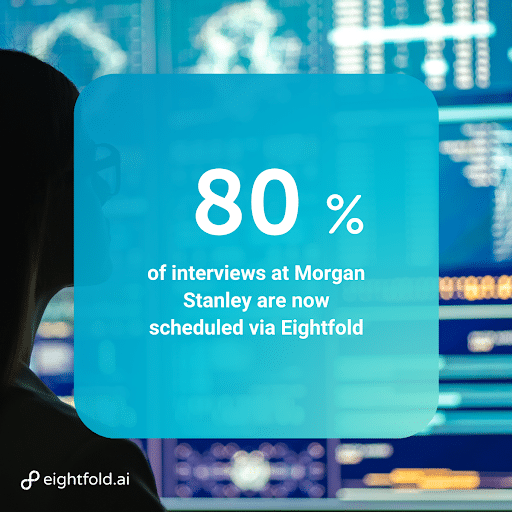- Morgan Stanley improved recruiter efficiency by 20%, automated 80% of interview scheduling, and unlocked time and resources to reinvest in other areas of talent acquisition using the Eightfold Talent Intelligence Platform.
- AI agents are transforming the workforce and unlocking new value at speed, but success depends on pairing these with the right strategy, technology, and narrative.
- True transformation starts at the top. When the C-suite is actively engaged from day one, organizations can accelerate buy-in and build lasting momentum for AI.
As the agentic AI transformation takes hold, workforces are expanding without adding to their head count.
Right now, HR operations have an unprecedented opportunity to drive real change to deliver value to their organizations by shaping the work and workers of tomorrow.
To do so, three elements are essential: the right strategy, the right technology, and the right buy-in.
“We have to get out of our own way to say, ‘How can I use this in a manner that will encourage other people to use the capability and try the transformation and innovation?’ ” said Anthony Abbatiello, Partner, Workforce Transformation Practice Leader at PwC at our Cultivate ’25 event.
When that happens, he adds, the impact will ripple across the entire enterprise. “Agents mimicking human behavior and activity will now start to create greater value. It’s not just about ROI from a financial perspective,” he said. “But it is about the value that it’s bringing to the organization at large.”
Abbatiello led a conversation about this topic with Martin Vergara, Global Head of Talent Acquisition at Morgan Stanley, to discuss the importance of C-suite buy-in and the need for aligning HR, AI agents, and organizational priorities when it comes to adopting and scaling AI.
Vergara shared some of the top lessons he’s learned while transforming Morgan Stanley’s approach to talent acquisition and management. From starting small to tech investments reflecting core values, these six lessons offer something to everyone looking to get leadership buy-in for AI in HR practices.
Global Head of Talent Acquisition Martin Vergara shares why Morgan Stanley was ready to change its approach to hiring and investing in AI.
1. Humility is essential.
Morgan Stanley’s need for transformation was sparked by some humbling lessons, said Vergara. Emerging from the COVID-19 pandemic and the Great Resignation, it became clear to talent acquisition leaders that they needed new ways in to attract and retain talent.
“We never thought about an employee value proposition before because we’re Morgan Stanley. You should want to work for us, right?” Vergara said.
Around that same time, a new CHRO joined the firm who understood the importance of investing in AI and other technologies.
“That’s when HR embarked on a big modernization program,” Vergara said.
2. It helps to bring in partners sooner vs. later.
Many early conversations revolved around critical topics like data privacy, risk, and compliance. To ensure that leaders across the organization felt included, Vergara said they created a “squad advisory board” filled with various division heads, COOs, and other C-suite executives.
“We laid it upfront for leaders across the firm: This is our plan. We want your fingerprints on it,” Vergara said. “Because of that, we were able to run towards some of those issues more directly by having that strong communication framework.”
Vergara shares how AI has helped Morgan Stanley adopt new skills across its workforce and change the path forward as an organization.
3. Your technology investments should reflect your core values.
Is your organization walking the walk? At Morgan Stanley, Vergara said they’ve had discussions about what kind of organization they want to be, then determine what that might look like.
“At the end of the day, we don’t create widgets or iPhones or things like that. People are our talent,” he said. “We pride ourselves on delving into complexity and being great at what we do across all our different verticals.”
One of the organization’s core values is leading with exceptional ideas. That’s something that should happen within every department — including HR.
Investing in the right technology at the right time reflects those values.
4. Starting small can help build trust and support.
Transformations don’t happen overnight. In the case of Morgan Stanley, the first phase involved a pilot program with about 400 people.
“We were able to work with our partners in legal compliance and risk,” Vergara said. “We were able to work on content management. We were able to work on all the various issues to build that internal confidence.”
Now that they’ve established trust and familiarity by starting small, the team is working on rolling out other projects and products.

5. Savings from AI should be reinvested in other areas.
By using the Eightfold Talent Acquisition, Vergara reported that Morgan Stanley achieved 20% efficiency within its recruiter and source ratios, and 80% of their interviews are now scheduled via Eightfold.
By saving time and unlocking value, Morgan Stanley’s leadership is able to reinvest in other areas of talent acquisition.
6. When launching AI initiatives, HR is a great place to start.
AI isn’t slowing down, and for organizations wondering where and how to get started, HR is a logical place to kick things off.
“Whether we realize it or not, we’re all in that human capital employee experience business,” Vergara said. “They’re all going to look to us to figure out things like, ‘How should I approach this?’ ‘How should I handle this?’ ‘What’s the impact of this going to be?’ We’re going to be getting questions whether we want them or not.”
By embracing a mindset of innovation and investing in new technologies, the HR team will then be in a better position to help the rest of the firm, when and where they need it.
Putting lessons into practice
The rise of agentic AI is not just a technology shift — it’s a leadership moment.
As Morgan Stanley’s experience shows, success comes from humility, early partnership, and a clear alignment between values and technology. Starting small, reinvesting wisely, and anchoring AI in HR can create ripple effects that reshape the entire organization.
For HR leaders and the C-suite alike, the path forward is clear: lean into experimentation, build trust across the enterprise, and reimagine how people and AI can work together to unlock value.
Those who seize this moment will not only transform their workforce but also position their organizations to thrive in the future of work.
Watch the full session from Cultivate ’25, available now on demand.
